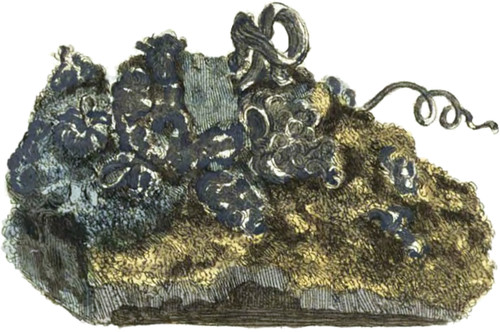 Enlarge
Enlarge
British Mineralogy
Capillary Silver
- Class 3. Metals.
- Ord. 1. Ductile.
- Gen. 3. Silver.
- Spec. 1. Native Silver.
- Div. 2. Imitative.
- Gen. Char. The whitest of all known metals, very malleable, and sonorous; specific gravity before hammering, 10.474; after; 10.510. Dissolves readily in nitric acid, and may be precipitated from it by copper, iron, or zinc. Rmeains in fusion at 28° of Wedgewood, but requires a greater heat to fuse it.
- Spec. Char. Ductile with but a small portion of alloy.
- Syn.
- Argentum nativum. Waller, v. 2. 238. Linn. Syst. ed. 12. v. 3. 148.
- Native silver. Kirwan, v. 2. 108. Bab. 146.
- Gediegen silber. Emmerling, v. 2. 153.
- Argent natif. Haüy, v. 3. 384.
In June 1799, soon after the discovery of native silver in the Herland copper mine, in the paris of Gwinear, about 7 miles from St. Michal’s Mount, I had the pleasure of calling there in company with my friend D. Turner, Esq., and was lucky enough to procure some rich little pieces, which served my purpose, and gave me the most satisfactory pleasure of gratifying a few friends. According to the Rev. Malachi Hitching’s account, in Phil. Transac. for 1801, page 169, “the lode in which it occurs is one of those cross courses which intersect and derange the copper lodes, and are consequently of a more recent formation. No ores of silver were observable in this lode till the epth of 110 fathoms from the surface, and at the further depth of 32 fathoms they disappeared. The richest mass of silver ore was found at the depth of 2 fathoms above the level at which it disappears. About 108 tons of it are said to have been raised. The silver ore, strictly speaking, is a mixture of galæna, native bismuth, gray cobalt ore, vitreous silver ore, and native silver.”
Our specimen seems to be the galæna decomposing and protruding the silver; itself remaining of a cinereous appearance, losing its natural brilliancy. There are also some pyrites and bits of quartz. The silver protruded is nearly pure, and has been (from its curling appearance) compared by the people of Penzance to the scrapings of silver spoons. The silver for coin and manufacturing is alloyed with copper, which does not affect the whiteness, and is not easily detected, unless in too great proportion, when it may sometimes be tasted. It may be made very thin as leaf silver, one grain thus formed measuring more than 51 square inches. It is often used to plate over copper or iron, and wire so made serves for musical instruments, &c. A wire one tenth of an inch in diameter will support 270 pounds of weight.
Silver, by being dissolved in nitric acid, and precipitated with mercury, will form the likeness of a tree, and is then called Arbor Dianæ.—If precipitated from the nitric acid by lime water, the precipitate dried, and washed with a solution of pure ammoniac, has a dangerous fulminating property; and on the slightest touch, or friction, will explode most violently, exceeding the force of gunpowder. The nitrate of silver stains animal substances a deep black, and has been used to blacken human hair; but it is extremely dangerous, owing to its corrosive property.

